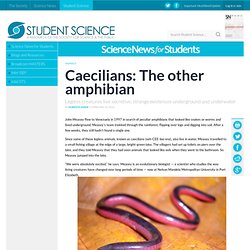

Gallery. Caecilians: The other amphibian. Measey---S-vittatus Measey---Close-up-3 Kupfer---Boulengerula-and-young Biju---Egg Lungless-species-high-res John Measey flew to Venezuela in 1997 in search of peculiar amphibians that looked like snakes or worms and lived underground.

Since some of these legless animals, known as caecilians (seh-CEE-lee-enz), also live in water, Measey travelled to a small fishing village at the edge of a large, bright-green lake. “We were absolutely excited,” he says. Caecilians belong to the same group of animals that includes frogs and salamanders. “The whole creature is really quite bizarre,” says Emma Sherratt, an evolutionary biologist at Harvard University. Not a snake, not a worm Scientists first started studying caecilians in the 1700s. Biologists know very little about these creatures, compared with other animals. “This is a major group of living creatures, and so few people even know they exist,” says Sherratt. As these animals spent more time underground, they evolved to become better burrowers. Kings of Camouflage. Kings of Camouflage PBS Airdate: April 3, 2007 NARRATOR: Imagine an alien that can float through space, with a giant brain shaped like a doughnut, eight arms growing out of its head, and three hearts pumping blue blood.

This alien lives right here on Earth. It's called the cuttlefish, a flesh-eating predator who's a master of illusion, changing its shape and color at will. It can hypnotize its prey or even become invisible. MARK NORMAN (Museum Victoria): They've developed this skin that can do the amazing changes in color and changes in shape. ROGER HANLON (Marine Biological Laboratory): Every place they go, they are morphing into something that looks a lot like that environment.
NARRATOR: How does an animal that's related to a slug manage such clever tricks? MARK NORMAN: You get a sense there is a hell of a lot going on in those brains, but we're struggling to, kind of, understand how they work. JESSE PURDY (Southwestern University): We are testing an animal that's very alien. In she goes. Arctic Biologist Shares Astonishing Sea Creatures With the World. There is no road to the White Sea Biological Station, which sits at latitude 66° N on the cusp of the Arctic Circle.

Located on the shores of its namesake, the White Sea, the only way to get there is by boat in summer and snowmobile in winter since the waters of Kandalaksha Bay are frozen six months out of the year. Inside the station is an unlikely photo studio where Alexander Semenov, 25, is sharing his stunning photographs of arctic sea creatures with the global online community. “I’m trying to act like the Discovery channel, but as a single unit,” says Semenov. Alexander Semenov on the White Sea Biological Station dock. A marine biologist, photographer and head of the WSBS deep-sea diving team, Semenov has been stationed at the WSBS since 2007. “I think all the people in the world know how tigers and lions looks like, but only a few ever know about scyphozoan jellies – that they can grow up to 3 meters in diameter and have tentacles of 36 meters,” says Semenov.